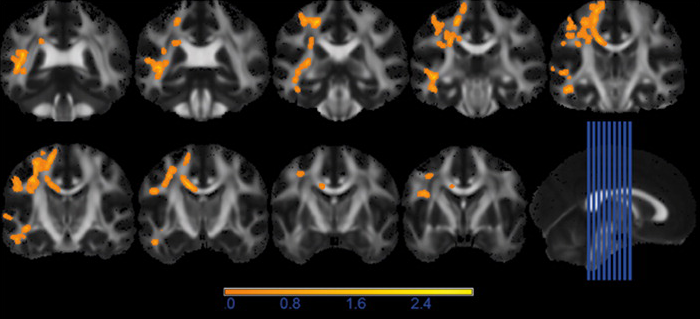Paper Lena Filatova published in Radiology: "White Matter by Diffusion MRI Following Methylphenidate Treatment: A Randomized Control Trial in Males with Attention-Deficit/Hyperactivity Disorder"
Treatment with methylphenidate appears to affect specific tracts in brain white matter in boys with attention-deficit/hyperactivity disorder according to this study published in the journal Radiology.
Background
Methylphenidate (MPH) is highly effective in treating attention-deficit/hyperactivity disorder (ADHD). However, not much is known about its effect on the development of human brain white matter (WM).
Purpose
To determine whether MPH modulates WM microstructure in an age-dependent fashion in a randomized double-blind placebo-controlled trial (Effects of Psychotropic Medication on Brain Development–Methylphenidate, or ePOD-MPH) among ADHD referral centers between October 13, 2011, and June 15, 2015, by using diffusion-tensor imaging (DTI).

Materials and Methods
In this prospective study (NTR3103 and NL34509.000.10), 50 stimulant treatment–naive boys and 49 young adult men diagnosed with ADHD (all types) according to Diagnostic and Statistical Manual of Mental Disorders, 4th Edition criteria were randomized to undergo treatment with MPH or placebo for 16 weeks. Before and 1 week after treatment cessation, study participants underwent MRI, including DTI. The outcome measure was change in fractional anisotropy (FA), which was assessed in three regions of interest (ROIs), as well as in a voxel-based analysis in brain WM. Data were analyzed by using intention-to-treat linear mixed models for ROI analysis and a permutation-based method for voxel-based analysis with family-wise error correction.
Results
Fifty boys (n = 25 MPH group, n = 25 placebo group; age range, 10–12 years) and 48 men (n = 24 MPH group, n = 24 placebo group; age range, 23–40 years) were included. ROI analysis of FA yielded no main effect of time in any of the conditions. However, voxel-based analysis revealed significant (P < .05) time-by-medication-by-age interaction effects in several association tracts of the left hemisphere, as well as in the lateral aspect of the truncus of the corpus callosum, due to greater increase in FA (standardized effect size, 5.25) in MPH-treated boys. Similar changes were not present in boys receiving a placebo, nor in adult men.
Conclusion
Four months of treatment with methylphenidate affects specific tracts in brain white matter in boys with attention-deficit/hyperactivity disorder. These effects seem to be age dependent, because they were not observed in adults treated with methylphenidate.
The whole article can be read here.